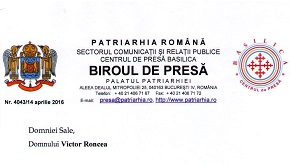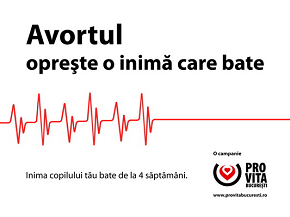
 Un document descoperit de colegul meu, George Damian, de la ZIUA si Centrul de Studii pentru Resurse Romanesti, publicat acum, aici, in premiera in Romania, ne ofera argumente juridice si medicale impotriva folosirii cipului biometric implantat dar si a celui inserat in cadrul documentelor de identitate, pentru ca principiile privind drepturile fundamentale ale omului raman aceleasi.
Un document descoperit de colegul meu, George Damian, de la ZIUA si Centrul de Studii pentru Resurse Romanesti, publicat acum, aici, in premiera in Romania, ne ofera argumente juridice si medicale impotriva folosirii cipului biometric implantat dar si a celui inserat in cadrul documentelor de identitate, pentru ca principiile privind drepturile fundamentale ale omului raman aceleasi.
Studiul, chiar daca dateaza din 2005 (cu atat mai mult) trebuie sa intre in atentia Coalitiei Impotriva Statului Politienesc, a domnului doctor Pavel Chirila si a avocatilor nostri dar si a ierarhilor Bisericii care, inca, nu s-au pronuntat.
Iata ca cei care sugerau ca trebuie sa ne conformam cerintelor UE nu au dreptate. Acestea nu sunt, inca, definite. Inca nu avem de a face cu Uniunea Sovietelor Socialiste Europene.
OPINION OF THE EUROPEAN GROUP ON ETHICS IN SCIENCE AND NEW TECHNOLOGIES TO THE EUROPEAN COMMISSION
N° 20 Adopted on 16/03/2005
Original in English
******************************************************************************************************************
ETHICAL ASPECTS OF ICT IMPLANTS IN THE HUMAN BODY
Reference: Opinion produced on the direct initiative of the EGE
Rapporteurs: Professor Stefano Rodotà and Professor Rafael Capurro
******************************************************************************************************************
The European Group on Ethics in Science and New Technologies (EGE),
Having regard to the European Union Treaty and in particular Article 6 of the common provisions concerning the respect for fundamental rights;
Having regard to the EC Treaty and in particular Article 152 on public health;
Having regard to the Charter of Fundamental rights of the European Union of 28 September 2000, approved by the European Council in Biarritz on 14th October 2000 and proclaimed solemnly in Nice by the European Parliament, the Council and the Commission on December 7th 2000, in particular Article 1 on « Human dignity », Article 3 on the « Right to the integrity of the person », and Article 8 on « Protection of personal data »; 1
Having regard to Directive 2002/58/EC of the European Parliament and of the Council of 12 July 2002 concerning the processing of personal data and the protection of privacy in the electronic communications sector; 2
Having regard to Directive 95/46/EC of the European Parliament and of the Council of the European Union of 24 October 1995 on the protection of individuals with regard to the processing of personal data and on the free movement of such data; 3
Having regard to the Council Directive 90/385/EEC of 20 June 1990 on the approximation of the laws of the Member States relating to active implantable medical devices; 4
Having regard to the Council of Europe Convention on Human Rights and Biomedicine, signed on 4 April 1997 in Oviedo; in particular Article 1 “Purpose and object”, Article 2 “Primacy of the human being”, Articles 5 to 9 on consent and Article 10 “Private life and right to information”; 5
Having regard to the Universal Declaration on the human genome and the rights of man adopted by the UNESCO on 11 November 1997; 6
Having regard to the Convention for the Protection of Individuals with regard to Automatic Processing of Personal Data of the Council of Europe of 1 January 1981; 7
Having regard to the Declaration of Principles of the World Summit on the Information Society of 12 December 2003, in particular Article 58 on the use of ICTs and Article 59 on the abusive uses of ICTs; 8
Having regard to the hearings of experts and Commission Services by the EGE on 15/12/2003, 16/03/2004 and 15/06/2004 in Brussels;
Having regard to the report by Dr Fabienne Nsanze “ICT implants in the human body – A Review”, February 2005; 9
Having regard to the Roundtable organised by the EGE on 21st December 2004 in Amsterdam; 10
Having heard the EGE rapporteurs, Professor Stefano Rodotà and Professor Rafael Capurro;
WHEREAS:
1. INTRODUCTION
Information and communication technologies (ICT) pervade our lives. Thus far, this pervasive influence has mainly involved devices that we use for private purposes or at the work place such as personal computers, mobile phones, laptops and the like. Due to new developments these devices are becoming more and more part of our bodies, either because we wear them (wearable computing) or because they are implanted in our bodies.
At first sight ICT implants are ethically unproblematic if we think for instance about cardiac pacemakers. However, although ICT implants may be used to repair deficient bodily capabilities they can also be misused, particularly if these devices are accessible via digital networks. One might even think of such devices as a threat to human dignity and particularly to the integrity of the human body (see Section 5), while for others such implants might be seen primarily as a means for restoring damaged human capabilities and therefore as a contribution to the promotion of human dignity.
The idea of letting ICT devices get under our skin in order not just to repair but even to enhance human capabilities gives rise to science fiction visions with threat and/or benefit characteristics. However, in some cases, the implantation of microchips is already taking place with the potential for individual and social forms of control.
The intimate relation between bodily and psychic functions is basic to our personal identity. Modern neurosciences are emphasising this view. Language and imagination influence in a unique way our perception of time and space; the way we perceive ourselves and others; the way we relate to other non-human living beings and to the natural environment; the way we create historically, culturally, politically, legally, economically, and technically our societies; the way we acquire knowledge about ourselves and about the world; and the way we produce, create, and exchange things.
ICT devices are the products of human invention. The functions they achieve are based on programmable or algorithmic calculations mostly using non-biological substances such as silicon. This allows a simulation of some biological and psychic functions11. Furthermore, it is in principle, and today also in practice, possible to implant ICT devices in the human body in order
to restore bodily functions or, as in the case of prostheses and artificial limbs, to substitute some body parts.
These are the essential reasons why potential and actual ICT implants in the human body have large and important ethical consequences.
Consequently, the objective of this Opinion is primarily to raise awareness and questions concerning the ethical dilemmas created by a range of ICT implants in this rapidly expanding field. Ethical awareness and analysis must take place now in order to ensure an appropriate and timely impact on the various technological applications. Nevertheless, where necessary this Opinion proposes clear ethical boundaries, legal principles and suggests several steps that should be taken by responsible regulators in Europe. The Opinion focuses on ICT implants in the human body (see Section 6.1).
2. GLOSSARY
ICT devices: Devices using information and communication technologies usually based on silicon chip technology.
Active medical device: Any medical device relying for its functioning on an internal and independent source of electrical energy or any source of power other than that directly generated by the human body or gravity.12
Active implantable medical device: Any active medical device which is intended to be totally or partially introduced surgically or medically, into the human body or by medical intervention into a natural orifice, and which is intended to remain after the procedure.13
Passive ICT implants: ICT implants in the human body that rely on an external electromagnetic field for their operation (see for example Section 3.1.1 the “Verichip”).
Online ICT implants: ICT implants that rely for their operation on an (“online”) connection to an external computer or which can be interrogated (“online”) by an external computer (see for example Section 3.1.2 Biosensors).
Offline ICT implants: ICT implants that operate independently of external ICT devices (perhaps after an initial setting up operation) (see for example Section 3.1.1 Deep Brain Stimulation).
3. SCIENTIFIC AND TECHNICAL BACKGROUND
(See detailed report by Dr Fabienne Nsanze “ICT implants in the human body – a review” of February 2005 – annexed to this Opinion)
3.1. Current Applications and Research
3.1.1. Applications: ICT implants on the market
This section contains information about implants in the human body that are available in commercial form and have been researched, in some cases, for decades.
Active medical devices
The history of implantable devices in clinical practice started in the 1960s with the development of the first heart pacemakers to replace the autonomic rhythm of the heart. Systems for bladder stimulation that allow paraplegics (paralysis of the lower limbs often resulting from spinal cord injuries) to control voiding followed in the 1980s. The most recent examples of active implants for functional electrical stimulation are stimulators to treat pain in patients with tumours and trembling caused by Parkinson’s disease, and to restore the grasp function in quadriplegics (paralysis of the arms, legs and trunk below the level of an associated spinal cord injury). Typical devices include the following:
• Cardiovascular pacers for patients with conduction disorders or heart failure
• Cochlear implants: the cochlear implant differs from the hearing aid in that it does not amplify sound and bypasses the damaged part to send sound signals directly to the auditory nerve.
• Auditory Brainstem implant (ABI) is an auditory prosthesis that bypasses the cochlea and auditory nerve to help individuals who cannot benefit from a cochlear implant because the auditory nerves are not working. The brainstem implant stimulates directly the cochlear nucleus situated in the brainstem.
• Implantable programmable drug delivery pumps:

 January 26th, 2009
January 26th, 2009  VR
VR 
 Posted in Uncategorized
Posted in Uncategorized  Tags:
Tags: 





































Traiasca Romania Mare!!!